Contents
- The evolution of C-VIC into the commercial product Lingraphica shows the mix of hard work and good luck that
makes tech transfer happen.
- The fingerspelling hand evolves in technology to
provide simpler operation and greater reliability as it moves on to clinical
evaluation.
- The Vocational Training Facility casts DeVAR, the
desktop vocational assistant robot, in a supporting role as it enables severely
disabled students learn useful desktop publishing skills through interactive
videodisc and hands-on experience.
- SIMM, the software for interactive musculoskeletal
modeling, takes flight as its two developers leave to form a company to enhance
SIMM and develop new biomechanics software.
- Tech Tranfer Briefs
A journey from concept to
commercialization - Lingraphica
Alvin H. Sacks and Richard Steele
Lingraphica is an assistive and therapeutic device for persons with aphasia,
a disorder in which the parts of the brain responsible for sending, receiving,
and interpreting language has been severely damaged, usually by some type of
brain trauma (e.g., stroke). At present there are nearly 1 million aphasic
individuals in the US, with 100,000 new cases annually. The story of how this
therapeutic device came into being is a fine tale of technology transfer:
In early 1984, a research scientist and linguist from this Center, Richard
Steele, PhD, met with a team of investigators from the Boston Aphasia Research
Center to discuss opportunities for collaborative R&D. The Boston team
described work done in the early 70's on VIC, a low-tech visual communication
system for those afflicted with global aphasia. They presented a method of
communication which used decks of cards with pictures or symbols that could be
manipulated by the patient to produce meaningful, if elementary, communication.
It was evident to Steele and the other researchers that the method was both
cumbersome and limited and that it could be vastly improved and expanded by
intelligent use of the emerging personal computer technology that employed high
resolution graphic displays. He began formulating a project to develop a
computerized visual communication system for aphasics, dubbed C-VIC, which
would require only moving the mouse with one hand, since those affected by
stroke often also lose neurologic function on one side of their body. C-VIC
would simply involve manipulating a screen representation of the paper cards
which had been used in the original VIC system. These stacks of on-screen
"cards" contained the symbols and pictures needed for essential
communication.
With the concentrated involvement of Michael Weinrich, MD, then Chief of
Neurology at the Palo Alto VA Medical Center, as well as speech therapists and
a programmer, Steele proceeded, with VA funding, to develop, refine and test
the system on aphasic patients at several medical centers.

Patent sought for the basic technology
By 1987 the C-VIC system had demonstrated its functional value, and the
inventors filed a Disclosure of Invention with the General Counsel for their
agency, the Department of Veterans Affairs (DVA) in Washington, DC, as required
of all federal employees involved in technology development. In consideration
of the circumstances and the interests of the DVA, General Counsel informed the
researchers that the US Government was turning over all patent rights to them,
with the usual condition that the Government retain a royalty-free, paid-up
license to make and use the invention for government purposes.
In 1989, a license was negotiated between the inventors and an
entrepreneurial group in San Jose, CA for further development and
commercialization of the C-VIC technology. The following year, this group
formed a new start-up company, Tolfa, and sublicensed the C-VIC technology in
order to develop and market it as a commercial product. Shortly thereafter,
Tolfa hired the Principal Investigator and primary inventor, Richard Steele.
Even though this means of technology transfer may draw talent away from the
originating federal laboratory, it makes extremely good sense for the users of
the technology, particularly if further improvement and secondary products are
likely.

In the remarkably short time of just under one year (on February 7, 1991),
the commercial product - much improved, and renamed Lingraphica - appeared on
the market in the form of a specially labeled, dedicated Apple Macintosh
Portable computer, with Tolfa as a Value-Added Reseller, by agreement with
Apple Computer. The commercial product includes such features as voice and
animation. It also automatically records usage data for use by therapists. The
developer had applied for FDA approval of the device as a piece of Class 2
medical equipment, and the approval was received in December 1990. It is the
first equipment of its type for rehabilitation of persons with aphasia. In the
latter half of 1992, DVA sites in Phoenix, AZ, and Nashville, TN began a formal
evaluation of Lingraphica as a prosthetic device for speech-language
communication.
A patent application on the underlying technology was filed in 1990 with the
U.S. Patent and Trademark Office, and the patent was issued on December 8,
1992. In January 1993, the DVA formally approved the device for inclusion in
its list of prescribable prosthetic appliances for eligible veterans.
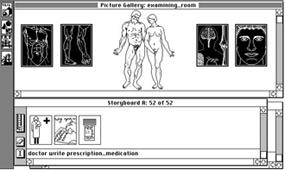 Lessons from the journey
Lingraphica is an excellent example of a successful rehabilitation product
invented in a DVA federal laboratory and commercialized by a private company.
Yet even in this most successful of cases, one should note the long time span
from conception to market - in this case nearly seven years!
Lessons from the journey
Lingraphica is an excellent example of a successful rehabilitation product
invented in a DVA federal laboratory and commercialized by a private company.
Yet even in this most successful of cases, one should note the long time span
from conception to market - in this case nearly seven years!
We learned several lessons from this experience, including the following:
- Tech transfer does not come about quickly, even in the best of
circumstances.
- The time from transferring a working laboratory prototype to seeing a
product on the market can be reasonably short if the company is small,
adequately funded, and smart and thorough in its approach.
- Hiring the inventor or developer is often critical to success.
- Even though the federal laboratory loses a valuable inventor or
investigator, there may be no more effective means of fulfilling its mission to
transfer its technology.
- The movement of promising technology to industry offers the private sector
valuable knowledge, expertise, and R&D which they might otherwise not be
able to afford.
Science, meet serendipity
Finally, we note the circumstances that brought about this licensing
arrangement. One day, shortly after the government had released the rights to
C-VIC to its inventors, an entrepreneur, later to be the president and CEO of
Tolfa, walked into the RR&D Center looking for potential products to
commercialize for the rehabilitation market. He selected C-VIC as the most
promising. He came to visit our Center at just that time because (1) he was in
the process of raising venture capital to start a new company, (2) he knew our
Director as a colleague, and (3) his wife is a physical therapist, familiar
with rehabilitation techniques. The product that grew out of this visit
illustrates one final lesson: as with many other endeavors in life, successful
tech transfer is the fruit of good preparation meeting the unexpected
opportunity of circumstance.
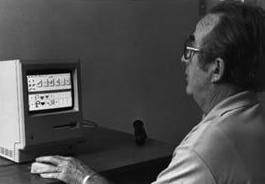
Early versions of C-VIC ran on a Macintosh Plus computer, shown here in use
by a person with aphasia.
For persons with aphasia, Lingraphica provides novel, important, and useful
support for improving communication in real-life situations. It does this by
providing access to an extensive database of more than 2000 'word-concepts',
each of which can display its meaning in graphics (e.g., icons, animated when
appropriate), text (printed word), and voice (digitized speech).
The system additionally allows such 'lingraphic icons' to be assembled into
larger constructions, to communicate sentence-like meanings (e.g., 'doctor
writes prescription'). Users may compose messages by pointing with the mouse
and dragging icons to 'storyboards', there, Lingraphica automatically
translates icon sequences into text and spoken words.
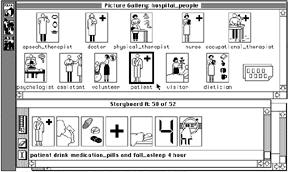 "Patient Screen," a
sample display screen showing the vocabulary window ("Picture
Gallery") above and the message construction window
("Storyboard") below.
"Patient Screen," a
sample display screen showing the vocabulary window ("Picture
Gallery") above and the message construction window
("Storyboard") below.
An able communicator can respond by typing text at the keyboard (with
automatic picture look-up). Storyboard communications may be stored for later
retrieval and reuse; they may also be written to diskette for transfer to, and
use on, a Lingraphica system elsewhere.
Lingraphica is a registered trademark of Tolfa Corporation.
A third generation fingerspelling
hand
David L. Jaffe
The first issue of OnCenter reported the development of Dexter, a computer
controlled mechanical hand that enables a deaf-blind individual to receive
tactile messages during person-to-person communication sessions - substituting
for a human interpreter - and to gain access to electronic information.
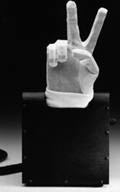
A smaller, lighter, and more intelligible version of Dexter has been
constructed under contract from Gallaudet University, with funding from NIDRR.
It, like its predecessor, translates keyboard key-presses or electronic
representations of letters into movements of the fingers of the mechanical
hand. In a technique called fingerspelling, these movements are felt by the
hand of a deaf-blind user and interpreted according to the American One-Hand
Manual Alphabet as letters comprising a message. With a fingerspelling hand, a
deaf-blind individual need not rely on a human interpreter for all
communication.
More reliable, better control
Significant improvements in the mechanical, computer, and software systems are
embodied in this new device. Mechanically, each hand motion is driven by a
servo motor as in Dexter. Cables are wound around the motors' pulleys, routed
up each finger, and attached to their tips. The fingers themselves are
constructed of Delrin segments attached to each other by a strip of carbon
fiber, replacing the torsion springs used in Dexter. The carbon fiber provides
the flexible hinge for finger flex and the restoring force necessary to extend
the finger.
The system's computer hardware consists of an 8 bit microcontroller module
and associated digital circuitry. This compact assembly unit is mounted behind
the servo motors under the hand. The computer software implements a new
fingerspelling algorithm that results in smooth transitions from one letter to
the next. Also, a finger-position editing utility makes it possible to optimize
the hand movements to increase intelligibility.
When using this system, a sighted person wishing to talk to a deaf-blind
individual interacts with the fingerspelling hand by using an Atari Portfolio
hand-held computer through a serial connection. In practice, any device that
produces serial data, including terminals, modems, computers, or modified
closed caption systems, could be used to control the hand.
In the fingerspelling mode, keypresses are entered on the Portfolio, and the
hand's software translates these keypresses into commands for the servo motors.
As the motor shafts rotate, they pull on the cables that are the
"tendons" of the fingers. It is by a coordinated series of motor
commands that keyboard input is transformed into choreographed motion
representing fingerspelling.
Clinical evaluation now in progress
Two fingerspelling hands have been constructed and will be placed in the homes
of several deaf-blind individuals for extended periods of clinical evaluation
through June, 1993. For successful commercialization, other tech transfer
issues need to be addressed beyond this evaluation. The market for
fingerspelling hands must be assessed, and a comprehensive plan for
manufacturer collaboration is needed to move this device out of the research
laboratory and into commercial availability.
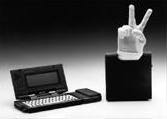
In our experience, encounters with Dexter have been enthusiastic, positive,
and at times, highly emotional. The increased communication capability and
ability to "talk" directly with people other than interpreters are
powerful motivations for using a fingerspelling hand. It has the potential to
provide deaf-blind users with untiring personal communication at rates
approaching that of a human interpreter.
This fingerspelling hand uses flexible carbon fiber hinges to connect the
finger segments and a hand-held computer for input and control.
VTF moves students into the
community
Machiel Van der Loos & Joy Hammel
The Vocational Training Facility (VTF) is a VA Merit Review Development
Project. Its goal is to provide an integrated and accessible learning
environment for students with severe physical disabilities such as high-level
quadriplegia from spinal cord injuries. Using the VTF curriculum in Desktop
Publishing (DTP), a student is in command of a self-paced curriculum on a
customized, accessible workstation. In three months, each student develops the
skills for entry-level competence in DTP. In transferring knowledge to the
students the VTF seeks to transfer the students to profitable employment.

During its first 18 months, the VTF developed a Macintosh-based curriculum
in Desktop Publishing instruction using a multimedia approach. The VTF
developed training materials on videodisc, evaluated and integrated
commercially available instructional materials, developed exercises and tests,
and wrote a HyperCard environment to allow a student to use all the different
learning tools. In addition, at the start of the three-month training sequence,
a workstation is tailored to each student's abilities. The list of possible
devices includes trackballs, keyboard holders, mouthsticks, voice-recognition
units, environmental controls, and DeVAR, the desktop vocational assistant
robot mounted over the workstation. The equipment assures that the students are
all capable of taking care of their daily living needs, even without the
assistance of an attendant, regardless of their level of ability.
The VTF is starting its third session this month. Our past two groups of
three students have shown that the course is a success. Five of the six have
gone on to 3-month internships in local companies and organizations to gain
real-world skills before hitting the job market. The one student who could not
complete the VTF course for medical reasons showed the value of the self-paced
approach to learning and is now continuing his DTP education at a local
college.
The VTF will continue until the end of 1993. By then, 15 to 18 students will
have been trained in DTP. This will be a very successful technology transfer in
and of itself. Beyond VTF, we see our curriculum as being appropriate for other
types of disabilities, as well as other learning forums such as community
colleges, and certainly for other vocational areas such as accounting, CAD, and
industrial training. We are very interested in pursuing the VTF concept with
industrial partners looking at individualizing their training methods and
making the materials accessible to students of all physical ability levels.

The DeVAR robotic assistant helps students learn Desktop Publishing skills
using a self-paced interactive-video curriculum.
Tech Transfer Briefs
Commercial partners sought for graphic Braille display Computer
access for the visually impaired person continues to challenge the ingenuity of
programmers and engineers. To date, computer interfaces for the blind have been
based on two techniques: text-to-speech and tactile sensing. Unfortunately,
speech output has several disadvantages, most notably that the text must be
presented in sequential order. Also, not all computer text can be easily or
meaningfully converted to speech. Tactile displays offer many potential
advantages but are currently limited by cost and complexity. An investigator at
this Center has recently completed a pilot project to develop an inexpensive,
quiet, reliable, energy-efficient Braille computer interface.
Biomedical Engineer Stefan Michalowski has designed and built a prototype
unit using a combination of mechanical and electrical components. The details
are not disclosed here in order to protect patentability, which is important
for potential manufacturers of a commercial device. The prototype has six pins
which are arranged in the Standard Braille pattern. It has been tested
extensively and has performed well. The current goal of the project is to
generate interest among commercial partners who would be willing to support the
transformation of this research prototype into a commercial product.
Joint project with Air Force on patient transport
Discussions are underway for a joint project in which this Center will work
with the US Air Force Armstrong Laboratory at Brooks AFB, San Antonio TX, to
improve stabilization of acute spinal injury patients during air evacuation and
hospitalization. This project will draw on experience here in technologies for
safe spinal stabilization during aeromedical and in-hospital transport of acute
spinal cord injury (SCI) patients. This expertise has been applied to the
design and evaluation of spinal stabilization devices used in local civilian
helicopter ambulances since 1985.
The Air Force is called upon to transport active duty service personnel from
the site of injury to regional DVA SCI Centers, and it is seeking methods of
safe spinal stabilization during short range transport and intercontinental
evacuation of patients with unstable spines. This project would apply both
motion analysis and accelerometry techniques to study the effectiveness of
various spinal stabilization devices. This is the first extensive collaboration
between the RR&D Center and the military. The DVA principal investigators
are Eric E. Sabelman, PhD and Inder Perkash, MD.
SIMM is now commercially
available
Peter Loan
As part of a project in surgery simulation at this Center, biomechanics
researchers in the Neuromuscular Systems Group developed the software package
SIMM (Software for Interactive Musculoskeletal Modeling). SIMM is a
graphics-based program designed to aid in the creation of mathematical models
of musculoskeletal structures which are then used to simulate the effects of
reconstructive surgical procedures.
To encourage the commercialization and continued development of the
software, the DVA released the patent rights for SIMM to the two inventors,
Scott Delp and Peter Loan. Delp and Loan subsequently formed a company,
MusculoGraphics, Inc., to market the software. Beyond its initial sales to
biomechanics researchers at university labs, MusculoGraphics is now expanding
its market to include several industrial sites.
The company has relocated to Evanston, IL, where it is continuing to enhance
SIMM as well as develop other biomechanics software. It recently hired two new
employees to help meet the growing demand for musculoskeletal modeling
software. For more information on SIMM, contact: Peter Loan, MusculoGraphics,
Inc. 1840 Oak Ave., Evanston, IL 60201.
For more information on any of these articles contact the author directly or
Al Sacks at 650/493-5000 ext 6-4475.